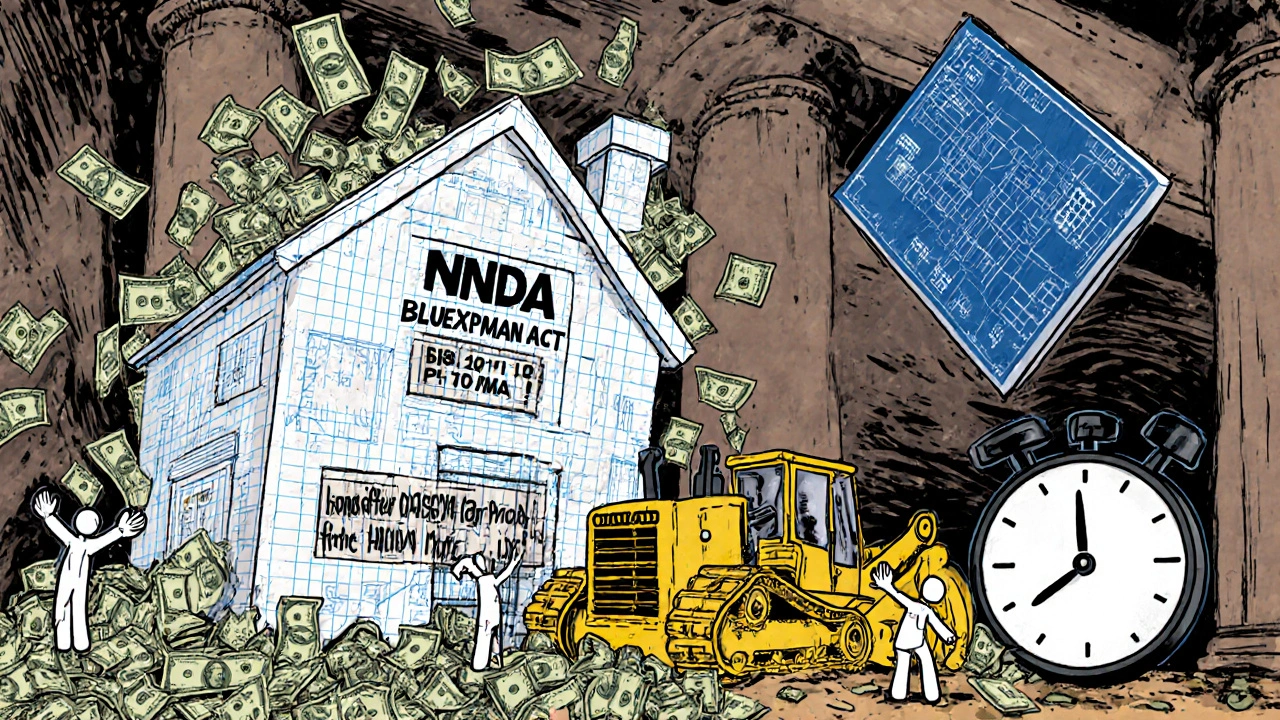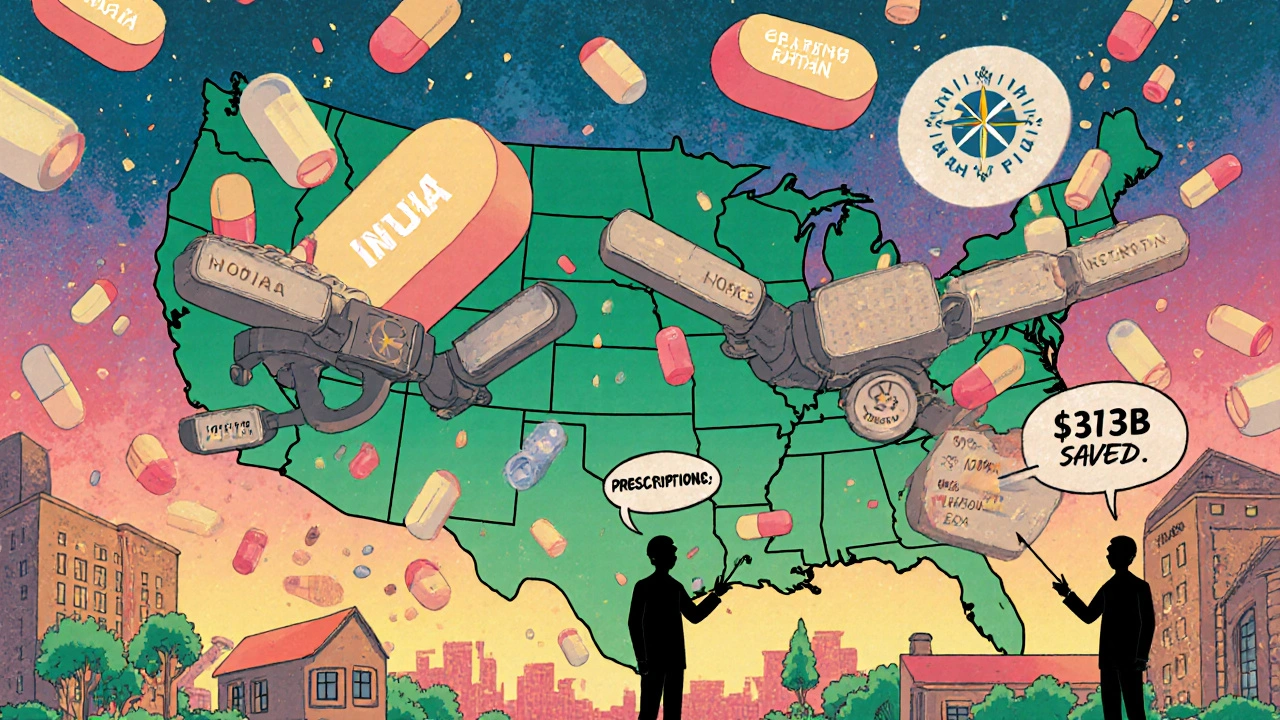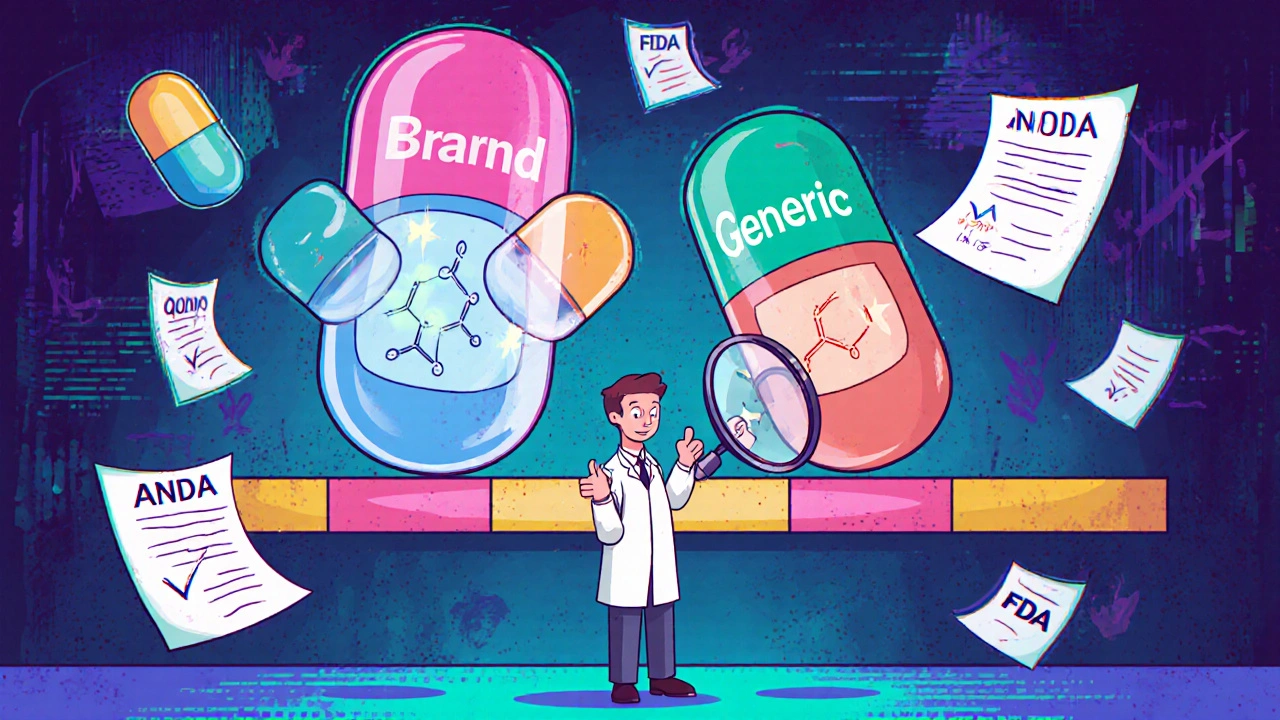Every time you pick up a prescription and see a lower price tag than the brand-name version, you’re seeing the result of something called an ANDA. That stands for Abbreviated New Drug Application. It’s not a drug itself-it’s the paperwork, the science, and the regulatory path that lets generic drugs hit the market. And it’s one of the most successful public health tools in modern medicine.
What exactly is an ANDA?
An ANDA is the formal request a company submits to the U.S. Food and Drug Administration (FDA) to sell a generic version of a brand-name drug. It’s called “abbreviated” because it doesn’t require the company to repeat all the expensive and time-consuming clinical trials the original drug maker had to do. Instead, the generic company proves their version is the same in every way that matters: same active ingredient, same strength, same way it’s taken (pill, injection, cream), and same effect on the body. The key word here is equivalent. The FDA doesn’t just want the pill to look alike. It needs to work alike. That means when you swallow a generic version of, say, metformin or lisinopril, your body absorbs it at the same rate and to the same extent as the brand-name version. No more, no less.How did the ANDA pathway start?
Before 1984, if you wanted to make a generic drug, you had to prove its safety and effectiveness from scratch-just like the original maker. That meant years of testing and millions of dollars. Most companies didn’t bother. So patients paid more, and competition was rare. That changed with the Hatch-Waxman Act, signed into law by President Ronald Reagan on September 24, 1984. This law created two tracks: one for new drugs (called NDAs), and one for generics (ANDAs). The goal? Make it easier and cheaper to bring generics to market without sacrificing safety. The results? Over 11,000 generic drugs approved by the FDA as of 2023. And today, about 90% of all prescriptions filled in the U.S. are for generics. That’s not luck. That’s the ANDA system working exactly as designed.What’s in an ANDA submission?
You can’t just say, “This pill is the same.” You have to prove it. Here’s what the FDA requires:- Same active ingredient-The medicine that actually treats your condition must be identical in chemical structure and amount.
- Same dosage form-If the brand is a tablet, the generic must be a tablet. If it’s a liquid, the generic must be a liquid.
- Same strength-A 10mg pill can’t be replaced with a 5mg pill and call it equivalent.
- Same route of administration-Oral, injection, inhaler, patch-all must match.
- Bioequivalence data-This is the core. The company runs studies with 24-36 healthy volunteers. They measure how quickly and how much of the drug enters the bloodstream. The generic’s results must fall within 80-125% of the brand’s. That’s the FDA’s accepted range for therapeutic equivalence.
- Manufacturing details-The facility, the equipment, the quality controls. Every step must be documented and meet FDA standards.
- Labeling-The instructions, warnings, and usage info must match the brand’s, except for the company name and logo.
How is an ANDA different from an NDA?
Think of it this way: an NDA is building a house from the ground up. An ANDA is using the same blueprint, but hiring a different contractor.- NDA (New Drug Application): Requires full preclinical (animal) and clinical (human) trials. Takes 10-15 years. Costs about $2.6 billion.
- ANDA (Abbreviated New Drug Application): Uses existing data from the brand-name drug. Takes 3-4 years. Costs $1-5 million.

Why does the ANDA pathway matter?
In 2023, generic drugs saved the U.S. healthcare system $313 billion. That’s not a guess. That’s from the Association for Accessible Medicines. It’s more than the GDP of many countries. Imagine if every prescription you filled cost 80-85% more. That’s what happens without generics. People skip doses. They don’t refill. Chronic conditions get worse. Hospitals fill up. The ANDA system prevents that. The FDA says 97% of generic drugs approved through ANDAs are therapeutically equivalent to their brand-name counterparts. That’s not just close. That’s clinically identical.What’s not allowed under ANDA?
Not every drug can go generic this way. The ANDA pathway works best for simple, small-molecule drugs with well-understood behavior in the body. It doesn’t work well for:- Complex generics-Like inhalers, topical creams, or injectables where the delivery system matters as much as the drug itself.
- Narrow therapeutic index drugs-Where even tiny differences in absorption can cause harm (like warfarin or lithium).
- Biologics-These are large, complex molecules made from living cells. They follow a different pathway called biosimilars.
Who files ANDAs and how hard is it?
The big players? Teva, Viatris, Sandoz, and Mylan. Together, they control nearly half the U.S. generic market. But hundreds of smaller companies file ANDAs too. It’s not easy. The first submission often gets rejected. Why? Common reasons:- Insufficient bioequivalence data (27% of rejections)
- Manufacturing quality issues (32% of rejections)
- Poor labeling or incomplete patent certifications

What about patents and exclusivity?
The Hatch-Waxman Act didn’t just make generics easier-it gave them a head start. If a generic company challenges a patent on the brand-name drug and wins, they get 180 days of exclusive rights to sell their version before anyone else can. That’s a huge incentive. That’s why, when Humira’s patents started expiring in 2023, 12 different companies rushed to file ANDAs. They knew the 180-day window could mean billions in revenue. But if the brand-name company sues for patent infringement, the FDA can delay approval for up to 30 months. That’s called a “30-month stay.” It’s a legal battle disguised as a regulatory pause.What’s next for ANDAs?
The FDA’s new GDUFA IV program, launched in 2023, aims to raise first-cycle approval rates from 65% to 90% by 2027. That means fewer delays, faster access. They’re also expanding the ANDA pathway to cover more complex products. Nasal sprays, topical antifungals, and transdermal patches are now getting clearer guidance. By 2028, analysts expect complex generics to make up 25% of the market-up from 15% today. But there’s a risk. Over 80% of generic drug ingredients come from just two countries: India and China. A single factory shutdown, a shipping delay, or a regulatory crackdown can cause shortages. The FDA is aware-and starting to push for more diversified supply chains.Final thought: You’re using ANDAs every day
You might never hear the word “ANDA,” but you’ve felt its impact. Your $4 prescription for metformin. Your $10 generic version of Lipitor. Your child’s ADHD medication that doesn’t break the bank. That’s the ANDA pathway at work. It’s not flashy. It doesn’t make headlines. But it saves lives. It keeps people on their meds. It keeps the system from collapsing under the weight of drug prices. And it’s one of the few government programs that actually delivers on its promise: more access, lower cost, same results.Is an ANDA the same as a generic drug?
No. An ANDA is the application submitted to the FDA to get approval for a generic drug. The generic drug is the actual product you get at the pharmacy. The ANDA is the paperwork, data, and process that makes the generic legal to sell.
Are generic drugs as safe as brand-name drugs?
Yes. The FDA requires generic drugs to meet the same strict standards as brand-name drugs for purity, strength, quality, and performance. Studies show that 97% of generic drugs are therapeutically equivalent to their brand-name counterparts. Millions of people use generics every day with no difference in outcomes.
Why do generic pills look different from brand-name pills?
U.S. law requires generic drugs to look different from brand-name versions to avoid trademark infringement. That means different colors, shapes, or markings. But the active ingredient, dose, and effect are identical. The differences are only cosmetic or in inactive ingredients like dyes or fillers, which are checked for safety.
Can any company file an ANDA?
Any company can try, but it’s not simple. You need a manufacturing facility that meets FDA standards, a team that understands complex regulatory requirements, and the resources to conduct bioequivalence studies. Most successful filers are established pharmaceutical companies with experience in generics. Smaller companies often partner with regulatory consultants or outsource parts of the process.
How long does it take for an ANDA to be approved?
Under current FDA timelines, a standard ANDA takes about 10 months to review. But this doesn’t include the time it takes the company to prepare the application-often 3-5 years. Delays can happen if the FDA requests more data or if there are patent disputes. The FDA aims to approve 90% of ANDAs on the first try by 2027.
Are there any risks with generic drugs approved through ANDA?
The risk is extremely low for most drugs. The FDA’s approval process is rigorous. The main concerns are for complex products like inhalers or injectables, where bioequivalence is harder to prove. Also, supply chain issues-like reliance on overseas manufacturing-can cause shortages, but that’s a logistics issue, not a safety one. For standard oral medications, the safety record of generics is excellent.
